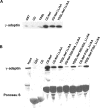Cooperative binding of the class I major histocompatibility complex cytoplasmic domain and human immunodeficiency virus type 1 Nef to the endosomal AP-1 complex via its mu subunit
- PMID: 18057255
- PMCID: PMC2224416
- DOI: 10.1128/JVI.00660-07
Cooperative binding of the class I major histocompatibility complex cytoplasmic domain and human immunodeficiency virus type 1 Nef to the endosomal AP-1 complex via its mu subunit
Abstract
Human immunodeficiency virus type 1 Nef provides immune evasion by decreasing the expression of major histocompatibility complex class I (MHC-I) at the surfaces of infected cells. The endosomal clathrin adaptor protein complex AP-1 is a key cellular cofactor for this activity, and it is recruited to the MHC-I cytoplasmic domain (CD) in the presence of Nef by an uncharacterized mechanism. To determine the molecular basis of this recruitment, we used an MHC-I CD-Nef fusion protein to represent the MHC-I CD/Nef complex during protein interaction assays. The MHC-I CD had no intrinsic ability to bind AP-1, but it conferred binding activity when fused to Nef. This activity was independent of the canonical leucine-based AP-binding motif in Nef; it required residue Y320 in the MHC-I CD and residues E62-65 and P78 in Nef, and it involved the mu but not the gamma/sigma subunits of AP-1. The impaired binding of mutants encoding substitutions of E62-65 or P78 in Nef was rescued by replacing the Y320SQA sequence in the MHC-I CD with YSQL, suggesting that Nef allows the YSQA sequence to act as if it were a canonical mu-binding motif. These data identify the mu subunit of AP-1 (mu1) as the key target of the MHC-I CD/Nef complex, and they indicate that both Y320 in the MHC-I CD and E62-65 in Nef interact directly with mu1. The data support a cooperative binding model in which Nef functions as a clathrin-associated sorting protein that allows recognition of an incomplete, tyrosine-based mu-binding signal in the MHC-I CD by AP-1.
Figures







Similar articles
-
An MHC-I cytoplasmic domain/HIV-1 Nef fusion protein binds directly to the mu subunit of the AP-1 endosomal coat complex.PLoS One. 2009 Dec 18;4(12):e8364. doi: 10.1371/journal.pone.0008364. PLoS One. 2009. PMID: 20020046 Free PMC article.
-
The tyrosine binding pocket in the adaptor protein 1 (AP-1) mu1 subunit is necessary for Nef to recruit AP-1 to the major histocompatibility complex class I cytoplasmic tail.J Biol Chem. 2008 Feb 8;283(6):3011-3022. doi: 10.1074/jbc.M707760200. Epub 2007 Dec 11. J Biol Chem. 2008. PMID: 18073204
-
HIV-1 Nef disrupts MHC-I trafficking by recruiting AP-1 to the MHC-I cytoplasmic tail.J Cell Biol. 2004 Dec 6;167(5):903-13. doi: 10.1083/jcb.200407031. Epub 2004 Nov 29. J Cell Biol. 2004. PMID: 15569716 Free PMC article.
-
HIV immune evasion disruption of antigen presentation by the HIV Nef protein.Adv Virus Res. 2011;80:103-27. doi: 10.1016/B978-0-12-385987-7.00005-1. Adv Virus Res. 2011. PMID: 21762823 Free PMC article. Review.
-
Structure, function, and inhibitor targeting of HIV-1 Nef-effector kinase complexes.J Biol Chem. 2020 Oct 30;295(44):15158-15171. doi: 10.1074/jbc.REV120.012317. Epub 2020 Aug 29. J Biol Chem. 2020. PMID: 32862141 Free PMC article. Review.
Cited by
-
Single-domain antibody-SH3 fusions for efficient neutralization of HIV-1 Nef functions.J Virol. 2012 May;86(9):4856-67. doi: 10.1128/JVI.06329-11. Epub 2012 Feb 15. J Virol. 2012. PMID: 22345475 Free PMC article.
-
An MHC-I cytoplasmic domain/HIV-1 Nef fusion protein binds directly to the mu subunit of the AP-1 endosomal coat complex.PLoS One. 2009 Dec 18;4(12):e8364. doi: 10.1371/journal.pone.0008364. PLoS One. 2009. PMID: 20020046 Free PMC article.
-
AP-2 Adaptor Complex-Dependent Enhancement of HIV-1 Replication by Nef in the Absence of the Nef/AP-2 Targets SERINC5 and CD4.mBio. 2023 Feb 28;14(1):e0338222. doi: 10.1128/mbio.03382-22. Epub 2023 Jan 9. mBio. 2023. PMID: 36622146 Free PMC article.
-
HIV-1 Nef: at the crossroads.Retrovirology. 2008 Sep 22;5:84. doi: 10.1186/1742-4690-5-84. Retrovirology. 2008. PMID: 18808677 Free PMC article. Review.
-
HLA-C as a mediator of natural killer and T-cell activation: spectator or key player?Immunology. 2011 May;133(1):1-7. doi: 10.1111/j.1365-2567.2011.03422.x. Epub 2011 Mar 1. Immunology. 2011. PMID: 21355865 Free PMC article. Review.
References
-
- Aiken, C., J. Konner, N. R. Landau, M. Lenburg, and D. Trono. 1994. Nef induces CD4 endocytosis: requirement for a critical dileucine motif in the membrane-proximal CD4 cytoplasmic domain. Cell 76853-864. - PubMed
-
- Akari, H., S. Arold, T. Fukumori, T. Okazaki, K. Strebel, and A. Adachi. 2000. Nef-induced major histocompatibility complex class I down-regulation is functionally dissociated from its virion incorporation, enhancement of viral infectivity, and CD4 down-regulation. J. Virol. 742907-2912. - PMC - PubMed
-
- Blagoveshchenskaya, A. D., L. Thomas, S. F. Feliciangeli, C.-H. Hung, and G. Thomas. 2002. HIV-1 Nef downregulates MHC-I by a PACS-1- and PI3K-regulated ARF6 endocytic pathway. Cell 111853-866. - PubMed
-
- Bresnahan, P. A., W. Yonemoto, S. S. Ferrell, D. G. R. Williams-Herman, and W. C. Greene. 1998. A dileucine motif in HIV-1 Nef acts as an internalization signal for CD4 downregulation and binds the AP-1 clathrin adaptor. Curr. Biol. 81235-1238. - PubMed
Publication types
MeSH terms
Substances
Grants and funding
LinkOut - more resources
Full Text Sources
Research Materials

